- eISSN 2353-8414
- Tel.: +48 22 846 00 11 wew. 249
- E-mail: minib@ilot.lukasiewicz.gov.pl
Consumer Engagement on Facebook: The Role of Comments in Travel Agency Brand Interactions in Poland
Dariusz Strzębicki
Institute of Economics and Finance, Warsaw University of Life Sciences
166 Nowoursynowska St., 02-787 Warsaw, Poland
E-mail: dariusz_strzebicki@sggw.edu.pl
ORCID: 0000-0003-1656-4268
DOI: 10.2478/minib-2025-0004
Abstrakt:
This article explores the role of Facebook posts as a tool for building consumer engagement with the travel agency community. A quantitative content analysis of the posts of Poland’s largest travel agencies reveals that while promotional posts received the most likes, interactive posts generated greater engagement in the form of more comments. Smaller agencies in some cases outperformed larger competitors in terms of comment frequency, highlighting the importance of content strategy. Analysis of the sentiment expressed in the comments showed the prevalence of mostly positive or neutral comments, with companies effectively managing negative comments. The findings suggest that interactive posts foster deeper consumer engagement, highlighting the need for travel agencies to diversify their content strategy and actively engage their audiences. The study recommends that travel agencies strive to optimize social media engagement by balancing promotional posts with interactive posts that encourage discussion, such as questions, surveys and other posts not related to advertising the products on offer. Moreover, analyzing sentiment in such comments can help refine a brand’s communication strategy, improving consumer relationships and brand perception.
MINIB, 2025, Vol. 55, Issue 1
DOI: 10.2478/minib-2025-0004
P. 56-68
Published March 19, 2025

Consumer Engagement on Facebook: The Role of Comments in Travel Agency Brand Interactions in Poland
1. Introduction
In the digital age, social media platforms play a crucial role in shaping consumer-brand interactions. Among these platforms, Facebook remains a dominant space for businesses, including travel agencies, to engage with their audience. One of the key indicators of consumer engagement on Facebook is the extent to which users comment on brand posts. Unlike simpler “likes,” comments reflect a deeper level of involvement, as they require users to actively express their thoughts, ask questions, or share experiences.
For travel agencies, consumer engagement on Facebook is particularly significant, given the experiential nature of tourism services. Travelers often seek inspiration, recommendations, and reassurance before making booking decisions, and brand interactions on social media can influence their perceptions and choices. Comments on Facebook posts serve as a public forum where potential customers interact not only with brands but also with other consumers, shaping trust and brand perception in the process.
This article examines the frequency and patterns of comments that appear on Facebook posts made by travel agency brands. By analyzing these interactions, we can assess whether these interactions imply meaningful consumer engagement. The findings will contribute to a broader understanding of social media engagement in the travel industry.
The primary objective of this article is to explore how Facebook posts serve as a tool for building engagement with the travel agency community, considering the top ten travel agency companies in Poland. The specific objectives are:
- to determine the frequency of comments on Facebook posts made by travel agency brands to assess the level of consumer engagement,
- to analyze the frequency of comments by post type.
- to categorize the content of the comments as positive, neutral or negative.
- to evaluate the relationship between comments and other engagement metrics (such as likes and shares).
2. Literature review
Brand building refers to the process of creating and enhancing a brand’s identity, value and reputation over time (Ghodeswar, 2008). It involves consistently delivering a strong brand message, building trust and creating positive brand associations. Social media is characterized by dynamic content, consumer-generated content (UGC) and online communities (Haile, 2023). The dominant social media outlets are social networks such as Facebook, where brands and consumers interact with each other. On social media sites, many companies make use of so-called brand pages, where consumers co-create the content of these pages (Poyry et al., 2013). These platforms allow brands to interact directly with their audiences, share content and participate in conversations. They change the traditional model of marketing communications, in which the role of consumers is not just to passively receive brand information, but also to co-create brand content (Okazaki and Tylor, 2013).
One of the most important goals of companies’ social media presence is to gain more consumer attention and engagement (Hanna et al., 2011). An important part of this process is publishing interesting content in the form of posts on the brand’s Facebook page. Brand posts can be diversified in terms of the role they play in brand promotion. They can be classified into different groups, such as the following (Luarn et al., 2015):
- informational posts – which contain information about the product, brand, company,
- reward posts – which present limited and special offers, samples, coupons,
- social posts – which function to encourage consumers to discuss and actively participate in the conversation,
- entertainment posts – which are not directly related to the brand and company, but offer fun and humor.
According to the concept of content marketing, the content of brand posts should convey to audiences what they are curious about and want, while maintaining the aesthetic quality of the message (Bakalarska-Stankiewicz, 2020). Post content is an important part of brand storytelling, as well as engaging consumers so that they interact with the brand and other consumers. A brand story is a cohesive narrative that incorporates a brand’s purpose, values and unique identity. It emotionally and intellectually connects the brand to its consumers, helping them understand what the brand is and why it exists (Da Costa, 2019). Social media makes the brand story more and more influenced by consumers themselves because, what they say is absorbed into the brand narrative (Lund et al., 2018). The brand story is also dynamic and takes place in real time. This helps brands participate in conversations about topics that are gaining popularity and adjust their narrative to be in line with topics that are important to consumers at the time.
Social media helps companies achieve consumer engagement. It is essential for brand building, as it enables the creation of relationships with the audience. Consumer engagement is defined as a mental state that is created through a customer’s interactive and co-creative experience with an object (such as a brand) (Hollebeek et al., 2014). Although positive brand evaluation may precede consumer engagement with brand pages and posts, consumer engagement with brand content has a positive impact on brand evaluation and consumer purchase intentions (Beukeboom et al., 2015). Engaged consumers show greater brand loyalty and satisfaction (Jayasingh, 2019). They are also more willing to contribute to product development of products and services (Kumar et al., 2010). Consumer engagement refers to the level of interaction, participation and emotional connection a consumer has with a brand. The behavioral dimension of brand engagement on social media includes activities such as viewing content, liking, commenting, sharing or creating brand-related content (Dessart et al., 2015).
High levels of engagement often lead to the creation of brand communities – groups of consumers who actively engage with the brand and each other, creating a collective identity around the brand. Engaged consumers contribute to discussions, share experiences and participate in brand activities. Companies’ social media activities help brands create engaged communities centered around the brand (Stopczynska, 2015). The motivations that make consumers want to engage in brand communities are varied and include, for example, a sense of belonging, emotional attachment to the brand, the search for knowledge, and the opportunity for self-expression and the need for recognition (Skorek, 2017). Sites such as Facebook allow companies to build online communities. Through communities, companies have the opportunity to engage consumers, listen to their opinions and respond to their inquiries and problems in an authentic way which helps to earn consumers’ trust and loyalty to the brand (Caslao et al., 2007). By involving customers in the brand community, companies can maintain regular interaction with them, which makes consumers pay more attention to the brand. When consumers feel part of a community they are more likely to trust the brand and remain loyal to it. Brands that actively engage in dialogue with their audience through comments, likes and taking part in the conversation with them build a stronger relationship with their audience. By doing so, they show that the brand cares about its consumers by increasing their trust.
There are three main levels that correspond to the path of gradual engagement with brand-related content on social media: consuming, contributing and creating (Muntinga et al., 2011). The consuming level represents minimal engagement. It involves reading and viewing content thematically related to the brand. Contribution means active participation in brand interactions in the form of likes, reactions, comments and sharing of brand-related content with other consumers. The co-creation level, on the other hand, means actively publishing brand-related content such as brand-related video, photos, videos, audio and writing articles. Dolan et al. (2016) propose a typology based on the intensity of engagement (active and passive engagement) and on consumers’ attitudes toward the brand (positive and negative engagement). Passive engagement involves viewing content without actively participating in the online community. Active engagement is characterized by active participation in online community activities by creating content and participating in dialogue with community members. Positive engagement occurs when consumers interact with a brand in a way that demonstrates satisfaction and loyalty. This type of engagement means that consumers have a positive opinion of the brand and are motivated to participate in brand-related activities or discussions. Negative engagement, on the other hand, occurs when consumers interact with the brand in a way that expresses dissatisfaction, frustration or negative feelings. Negative engagement often signals problems in consumers’ experience with a brand, but still reflects a level of engagement because consumers want to actively share their opinions or complaints.
From a branding perspective, consumer comments play a key role in shaping community perceptions of a company. The frequency, tone and content of comments provide valuable feedback for brands, allowing them to gauge how well messages resonate with their audiences. Comment analysis can give companies deeper insight into the overall mood of a brand’s online community. Sentiment analysis is the process of analyzing comments to determine if the emotional tone of the message is positive, neutral or negative. Positive comments indicate a satisfied and engaged audience, while negative comments may signal areas for improvement. Tracking these sentiments over time allows companies to understand how their brand is perceived and how they can improve their products, services or communication strategies.
Positive comments express satisfaction, appreciation or praise for a brand, its products, services or customer service. They contribute to a positive perception of the brand and often serve as informal recommendations or testimonials. Positive comments act as social proof, enhancing a brand’s reputation and encouraging new customers to trust the brand. Neutral comments, in turn, are usually factual, unbiased or informative. They do not express strong approval or disapproval and usually include questions, suggestions or general comments about the brand or its products. Neutral comments allow brands to interact directly with consumers, answering questions or acknowledging suggestions to build relationships and trust. Negative comments, by contrast, express dissatisfaction, complaints or criticism of a brand, its products, services or activities. They can range from mild concern to harsh criticism and can affect a brand’s reputation if not properly managed. Companies’ indifference to negative comments can damage a brand’s reputation and discourage potential customers.
3. Research methodology
This study analyzed the Facebook pages of selected travel agencies, to explore how posts serve as a tool for building engagement with the travel agency community. The primary research method employed was quantitative content analysis, which is a systematic and objective technique for analyzing the characteristics of communication content (Neuendorf, 2002). This method allows for the numerical measurement of various aspects of Facebook posts and user interactions, ensuring replicability and minimizing researcher bias.
Quantitative content analysis was used in this study to assess the frequency and patterns of consumer engagement in the form of comments on travel agency posts. The analysis focused on measurable attributes such as the number of comments per post, the types of posts generating the comments, and the nature of consumer interactions within the comment sections. By systematically categorizing and quantifying these elements, the study aimed to provide empirical insights into the role of comments as a manifestation of consumer engagement.
The stages of the study included:
- preliminary observation of the Facebook pages of travel agency websites;
- selection of variables for the study;
- selection of the research sample;
- conducting a proper content analysis of the Facebook pages of travel agencies.
Initially, a preliminary observation of travel agencies’ Facebook pages was conducted, in order to learn about the activity of travel agencies in publishing posts and engaging in interactions with consumers, especially in terms of the use of comments on posts. The selection of the sample was purposive. The 10 largest travel agencies in Poland in terms of revenue value and number of clients according to the 2024 ranking of the major Polish daily Rzeczpospolita were selected (Frydrykiewicz, 2024). Table 1 lists the travel agencies studied, their revenues, their number of customers and the addresses of their Facebook pages.
Based on the initial observation of the Facebook pages, variables were selected (shown in Table 2), which were next subjected to coding and counting in the content analysis process.
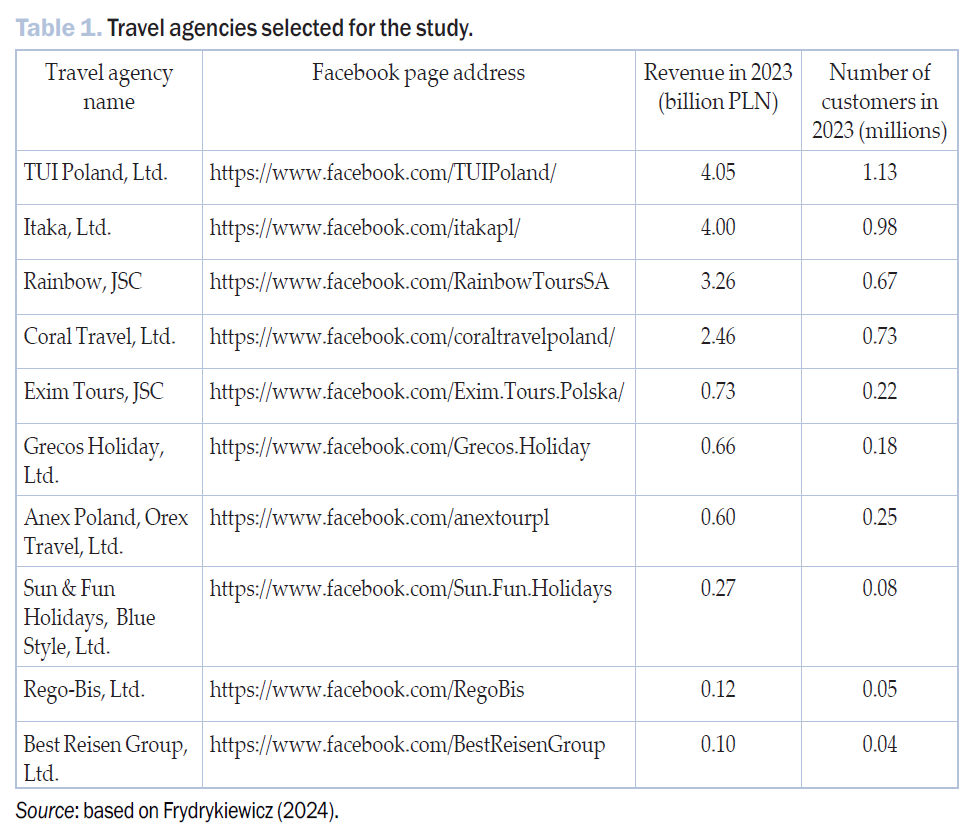
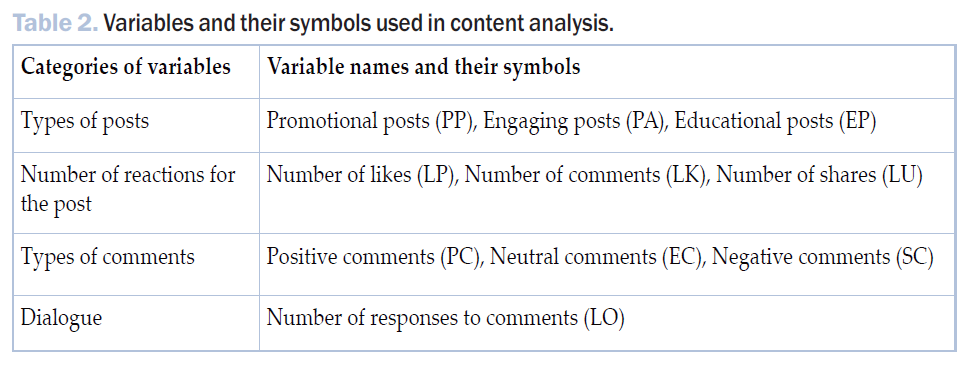
As shown in Table 2, a variety of variables were used in the study, falling into several different categories. During the initial observation, it was noted that the posts differed in terms of their purpose. Some of them were aimed at promoting the company’s offerings and were therefore categorized as promotional posts, while other posts were intended to engage consumers in a different way than by presenting the company’s offer, and therefore these posts were categorized as engaging posts. Some posts were also observed that aimed to provide consumers with relevant information about travel and tourism destinations in the form of, for example, videos and referencing articles. These posts were categorized as educational posts. Another category of variables included the number of likes, number of comments and number of shares for the posts studied.
The variables for the type of comments were categorized in terms of favorable or unfavorable impact on the brand. There were three types of comments: positive comments (KP), whose content was positive towards the brand and the company’s offerings, neutral comments, which were indifferent towards the product, brand and company or the post published, and negative comments, which expressed consumer dissatisfaction that could harm the brand.
Another category closely related to comments was the number of responses in the comments of the post. The number of responses in the comments section indicates that a dialogue is taking place in which the company and consumers are involved or consumers themselves are having a discussion in relation to the post. A high proportion of responses may indicate that the company is succeeding in engaging consumers in conversation and discussion in relation to the posts.
The actual content analysis study, which consisted of coding the occurrences of the variables on the surveyed travel agency Facebook pages, was performed in the month of July 2024. The 10 most recently published posts for each travel agency were coded, along with their comments. However, any posts published on the same day as the coding took place were excluded, on the grounds that consumers may not yet have had time to write comments on them, which would have distorted the results of the analysis. A total of 100 posts were analyzed.
4. Results
The content analysis study observed that the construction of posts overwhelmingly consisted of two basic elements, namely text or image. The image in the post was most often represented by a poster created on the basis of a photo of the facility being promoted, often accompanied by an advertising slogan or travel agency logo. Less frequently, the main image of the post was a video. The majority of posts contained links to specific offers and these were usually included in the text of the post or in a comment on the post, or the promotional poster often served as a link. Figure 1 presents the frequency of likes, comments, replies to comments and shares occurring in the sample of 100 posts.
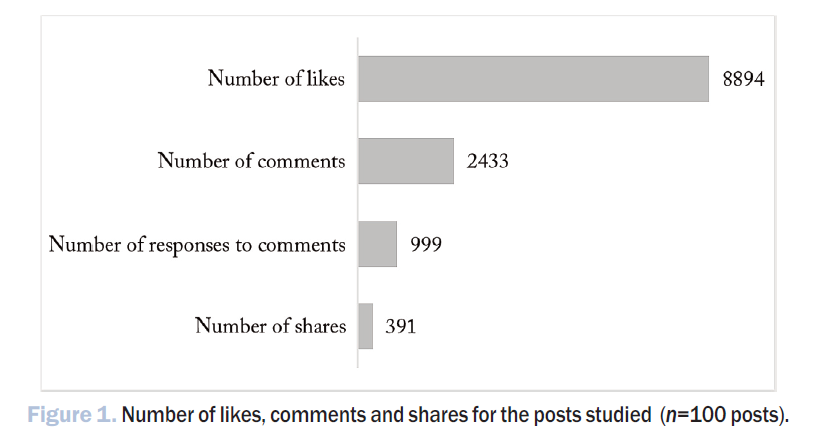
As shown in Figure 1, the number of likes for the surveyed travel agency posts was the highest, at 8894 likes, which corresponded to an average of approximately 89 likes per post. Given that comments represent a higher level of consumer engagement than likes, the number of comments on the surveyed posts, at 2433, should also be seen as relatively high, meaning that on average there were approximately 24 comments per surveyed post. The number of responses that were included in the group of comments was 999. Thus, responses to comments accounted for approximately 41% of the total number of comments surveyed, with an average of approximately 10 responses per post.
The posts analyzed varied in terms of the purpose of the content presented. Of the 100 posts analyzed, 68 (68%) were classified as promotional posts, 18 (18%) as engaging posts and 14 (14%) as educational posts. The three identified groups of posts were characterized by varying average values of likes, comments and shares, as shown in Figure 2.
The data presented in Figure 2 indicate that, due to the type of posts, there is a large variation in terms of consumer reactions to them. The highest average number of likes characterizes promotional posts. On the other hand, the highest average number of comments is seen for posts that aim to engage consumers through content other than advertising the services offered. The average number of responses to comments is also higher for posts classified as engagement posts. The average number of shares is highest for promotional posts, whereas educational posts generated higher levels of shares than engaging posts.
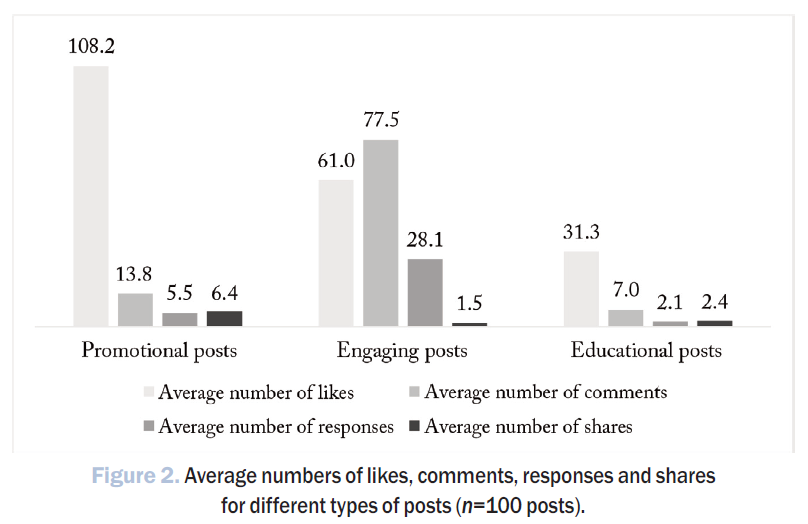
The companies surveyed varied in terms of the number of comments generated by their posts. In some cases, smaller travel agencies performed better in this respect than their larger competitors in terms of customer numbers and revenue.
The comments were also analyzed in terms of their potential impact on the brand. In particular, this analysis was carried out for the group of promotional posts due to the fact that comments on these posts have a direct reference to the brand compared to other types of posts. For the sample of 68 promotional posts, there were 939 comments. Figure 3 presents the share of the three types of comments on promotional posts.
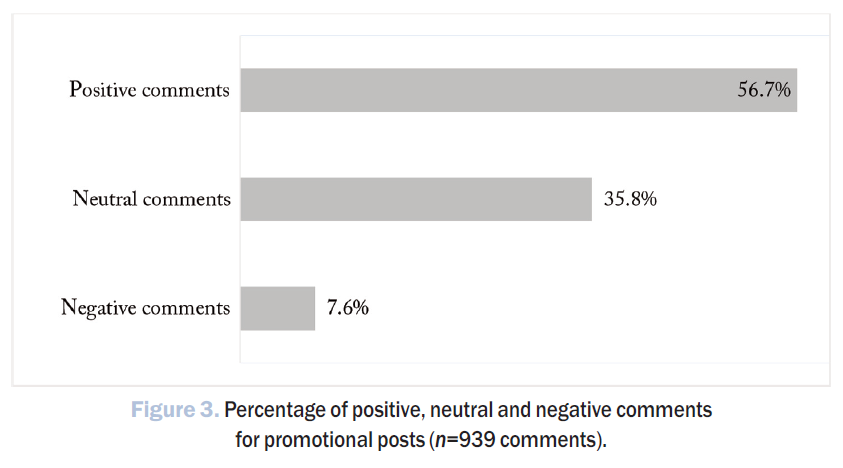
Figure 3 shows that the large majority of comments on promotional posts were positive from a brand impact perspective. Neutral comments were also common under the posts. Negative comments occurred infrequently. Observation of negative comments from consumers and the reaction to them by travel agencies revealed that the agencies most often tried to respond to them in a very tactful manner. Such behavior may in effect offset the potentially negative impact of negative comments on the brand and, as a result, may lead the brand to be perceived more favorably by consumers.
5. Conclusions
Social media has become a critical branding tool for businesses, with tourism companies being among the most active users for promotional purposes. Among the various social media platforms, Facebook remains a key channel for travel agencies to engage consumers, strengthen relationships, and build brand identity. Content shared on this platform facilitates both passive engagement (content consumption) and active engagement, such as liking, commenting, and sharing posts.
The findings of this study, based on an analysis of recent Facebook posts from ten of Poland’s largest travel agencies, indicate that these posts serve as a significant instrument for consumer engagement. The analyzed posts generated a substantial number of likes, comments, and shares, with differences in engagement levels across different companies. Interestingly, in some cases, smaller travel agencies outperformed their larger competitors in terms of comment engagement, suggesting that factors beyond company size and revenue influence consumer interactions.
The study identified a certain pattern of variation in engagement based on post type. Promotional posts, primarily aimed at advertising travel agency offerings, attracted the highest number of likes. In contrast, posts explicitly designed to encourage interaction and conversation (classified as “engaging” posts) elicited a significantly higher number of comments. Given that commenting requires a greater level of consumer involvement than liking a post, these findings suggest that engaging posts hold strong potential for fostering meaningful consumer-brand relationships and community-building.
An analysis of comment sentiment revealed that the majority of comments on promotional posts were positive, with neutral comments also being common, while negative comments were relatively infrequent. Importantly, travel agencies typically responded to negative feedback in a timely and tactful manner, mitigating potential reputational risks. This underscores the role of effective social media management in maintaining brand perception and consumer trust.
Based on the study’s findings, several recommendations can be made for travel agencies seeking to optimize their social media engagement strategies. While promotional posts generate high levels of less active engagement (likes), agencies should strive to increase the use of engaging posts to foster deeper consumer interaction and discussion. Creating content that invites comments, such as open-ended questions, polls, or interactive discussions, can help build a stronger brand-centered community. Proactive and tactful responses to consumer comments, especially negative ones, can enhance brand credibility and trust. Understanding consumer sentiment within comments can provide valuable insights into consumer perceptions and inform brand communication strategies.
Despite the insights gained, this study has certain limitations. The analysis was conducted on a relatively small sample of 10 posts per travel agency, resulting in a total of 100 posts. While this provides a certain overview of engagement trends, a larger dataset covering a more extended period could offer more comprehensive insights. Additionally, the study focused solely on quantitative metrics, such as the number of likes, comments, and shares, without an in-depth qualitative analysis of comment content beyond sentiment classification. Future studies could expand upon these findings by analyzing a larger dataset over an extended period to capture seasonal variations in consumer engagement. It may also be of interest to conduct qualitative analysis of comments to better understand the themes and consumer motivations behind engagement.
References
Bakalarska-Stankiewicz, J. (2020). Content marketing: Od strategii do efektów [Content Marketing: From Strategy to Effects]. Helion.
Beukeboom, C. J., Kerkhof, P., & de Vries, M. (2015). Does a virtual like cause actual liking? How following a brand’s Facebook updates enhances brand evaluations and purchase intention. Journal of Interactive Marketing, 32(1), 33. https://doi.org/10.1016/j.intmar.2015.09.003
Casaló, L., Flavián, C., & Guinalíu, M. (2007). The impact of participation in virtual brand communities on consumer trust and loyalty: The case of free software. Online Information Review, 31(6), 789–790. https://doi.org/10.1108/14684520710841766
Da Costa, C. (2019, January 31). 3 reasons why brand storytelling is the future of marketing. Forbes. https://www.forbes.com/sites/celinnedacosta/2019/01/31/3-reasons-why-brand-storytelling-is-the-future-of-marketing
Dessart, L., Veloutsou, C., & Morgan-Thomas, A. (2015). Consumer engagement in online brand communities: A social media perspective. Journal of Product & Brand Management, 24(1), 35–36. https://doi.org/10.1108/JPBM-06-2014-0635
Dolan, R., Conduit, J., Fahy, J., Brodie, R. J., Hollebeek, L. D., & Conduit, J. (2016). Social media engagement: A construct of positively and negatively valenced engagement behaviour. In R. J. Brodie, L. D. Hollebeek, & J. Conduit (Eds.), Customer engagement: Contemporary issues and challenges (pp. 102–103). Routledge.
Frydrykiewicz, F. (2024, April 30). Ranking biur podróży 2024: Dwaj liderzy na czele – Itaka Holdings i TUI Poland [Travel Agency Ranking 2024: Two Leaders at the Top – Itaka Holdings and TUI Poland]. Rzeczpospolita. https://turystyka.rp.pl/biura-podrozy/art40278371-ranking-biur-podrozy-2024-dwaj-liderzy-na-czele-itaka-holdings-i-tui-poland
Ghodeswar, B. (2008). Building brand identity in competitive markets: A conceptual model. Journal of Product & Brand Management, 17(1), 5. https://doi.org/10.1108/10610420810856468
Haile, T. (2023). Web’s progression: Moving from passive content consumption to active content creation and content validation. International Journal of Business and Management, 18(6), 136. https://doi.org/10.5539/ijbm.v18n6p135
Hanna, R., Rohm, A., & Crittenden, V. (2011). We’re all connected: The power of the social media ecosystem. Business Horizons, 54(3), 270–271. https://doi.org/10.1016/j.bushor.2011.01.007
Hollebeek, L. D., Glynn, M. S., & Brodie, R. J. (2014). Consumer brand engagement in social media: Conceptualization, scale development and validation. Journal of Interactive Marketing, 28(2), 149. https://doi.org/10.1016/j.intmar.2013.12.002
Jayasingh, S. (2019). Consumer brand engagement in social networking sites and its effect on brand loyalty. Cogent Business & Management, 6(1), 18. https://doi.org/10.1080/23311975.2019.1698793
Kumar, V., Aksoy, L., Donkers, B., Venkatesan, R., Wiesel, T., & Tillmanns, S. (2010). Undervalued or overvalued customers: Capturing total customer engagement value. Journal of Service Research, 13(3), 308–309. https://doi.org/10.1177/1094670510375602
Luarn, P., Lin, Y., & Chiu, Y. (2015). Influence of Facebook brand-page posts on online engagement. Online Information Review, 39(4), 3–4. https://doi.org/10.1108/OIR-01-2015-0029
Lund, N., Cohen, S., & Scarles, C. (2018). The power of social media storytelling in destination branding. Journal of Destination Marketing & Management, 8(7), 271–272. https://doi.org/10.1016/j.jdmm.2017.05.003
Muntinga, D. G., Moorman, M., & Smit, E. G. (2011). Introducing COBRAs. International Journal of Advertising, 30(1), 16. https://doi.org/10.2501/IJA-30-1-013-046
Neuendorf, K. A. (2002). The content analysis guidebook. Sage Publications.
Okazaki, S., & Taylor, C. (2013). Social media and international advertising: Theoretical challenges and future directions. International Marketing Review, 30(1), 67. https://doi.org/10.1108/02651331311298573
Pöyry, E., Parvinen, P., & Malmivaara, T. (2013). Can we get from liking to buying? Behavioral differences in hedonic and utilitarian Facebook usage. Electronic Commerce Research and Applications, 12(4), 224–235. https://doi.org/10.1016/j.elerap.2013.01.003
Skorek, M. (2017). Motywacja klientów do zaangażowania w społeczność wokół marki [Customer Motivation for Engagement in a Brand Community]. Marketing i Zarządzanie, 47(1), 245–246. https://doi.org/10.18276/miz.2017.47-22
Stopczyńska, K. (2015). Wykorzystanie social media w zarządzaniu wizerunkiem marki w sytuacji kryzysowej [The Use of Social Media in Brand Image Management During a Crisis]. Problemy Zarządzania, Finansów i Marketingu, 1(41), 175. https://doi.org/10.18276/pzfm.2015.41/1-13

